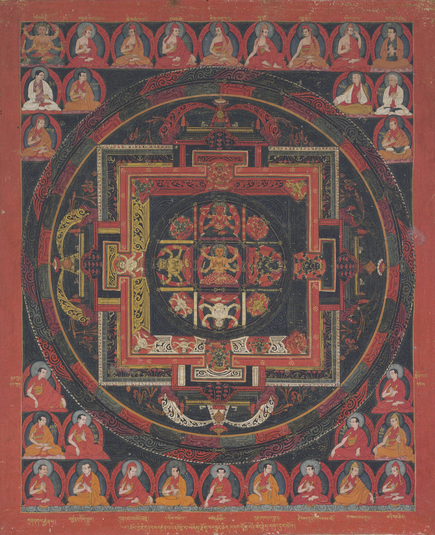
Item: Mandala of Guhyasamaja (Buddhist Deity) - Manjuvajra
| Origin Location | Tibet |
|---|---|
| Date Range | 1500 - 1599 |
| Lineages | Sakya, Ngor (Sakya) and Buddhist |
| Material | Ground Mineral Pigment on Cotton |
| Collection | Private |
Manjuvajra Guhyasamaja (circa 1550): surrounded by the Sakya and Ngor lineage for the transmission of Manjuvajra.
Jeff Watt 3-2020
-----------------------------------------------------------
The six-armed, three-headed image of the meditational deity Manjuvajra, the esoteric form of Manjushri, sits at the center of his celestial palace surrounded by eighteen retinue figures, as described in the Secret Assembly or Guhyasamaja Tantra. The Manjuvajra mandala originated with the commentarial tradition by the Indian pandit Jnanapada on the Guhyasamaja Tantra, translated in the eighth century. The mandala is the forty-fourth in the Gyude Kuntu, a compilation of texts explaining the significance of mandalas and initiations of the Sakya tradition. The mandala is further associated with the Ngor subschool of the Sakya tradition established by the Great Ngor Abbot, Kunga Zangpo (1382 – 1456), and the school is credited with the preservation of seven mandala rituals including Guhyasamaja, Hevajra, Chakrasamvara, Vajrayogini, Vajrabhairava, Sarvavidya and Mahakala.
The lineage of transmission, depicted here in the form of labeled portraiture, is recorded in the Collected Works of Amye Zhab Ngawang Kunga Sonam (1597–1659), the twenty-eighth Sakya throne holder and one of the great polymaths of the Sakya tradition. The last identifiable lineage holder depicted is the Tenth Ngorchen, Konchok Lhundrub (1497–1557). According to convention, the figure seated to his proper-right—the unknown figure Kunga Gyeltsen—must be his student. The lowermost inscription indicates that the painting was created after the death of that student: May the enlightened intent of Kunga Gyeltsen be thoroughly perfected! May I and all sentient beings be taken under his care! With this information, the painting can be dated to the second half of the sixteenth century.
The painting epitomizes the Beri style, the Newar legacy upon Tibetan painting styles demonstrated by the Sakya tradition. The relationship between Newar artists and Sakya patrons was developed by the twelfth century, a result of a connection formed at the Yuan imperial court between the renowned Newar artist Anige, and the Sakya lama Phakpa Lodro Gyeltsen (1235-1280), Kublai Khan’s first Imperial Preceptor. Recognizable Newar styles of representation including the use of registers, the color palette with strong red and blues; the quintessential vegetal scrollwork motif (referred to in Tibetan as “tree-leave cloud design”), and the petal-like crown; all visible in the earliest known Sakyacommissioned thangka depicting Amoghasiddhi from the twelfth century (Philadelphia Museum of Art, acc. no. 1994.148.609).
The present work, created four hundred years later than the well-known Amoghasiddhi, present the same stylistic and iconographic idiom. Paintings from Ngor Monastery in Central Tibet, such as the current work, exemplify the preservation of the Beri style from the fifteenth century onward (see D. Jackson, The Nepalese Legacy in Tibetan Painting, Rubin Museum, New York, 2010, p. 99). Compare the current work with a fifteenth-century Hevajra mandala at The Metropolitan Museum of Art (acc. no. 2015.551); which depicts figures with similar countenances and ornaments which surround the mandala, as well as the bold color palette.
The lowermost text indicates that it was created after the death of that student, as the inscription reads: "May the enlightened intent of Kunga Gyeltsen be thoroughly perfected! May I and all sentient beings be taken under his care!" With this information one can safely date the painting to the second half of the sixteenth century. The complete lineage is as follows:
1. Manjuvajra 2. Buddhashrijnana 3. Dipamkarabhadra 4. Shrideva 5. Vimala Gupta 6. Rinchen Dorje 7. Rinchen Drakpa 8. Paiṇḍapatika (11th century) 9. Nyen Lotsawa (11th century) 10. Nang Kaupa (aka Darma Sengge; 11th century) 11. Sachen Kunga Nyingpo (b.1092 – d.1158) 12. Sonam Tsemo (b.1142 – d.1182) 13. Drakpa Gyeltsen (b.1147 – d.1216) 14. Sakya Pandita (b.1182 – d.1251) 15. Pakpa Lodro Gyeltsen (b.1235-d.1280) 16. Kunga Drakpa 17. Tashi Pel 18. Kunga Sonam (13th century) 19. Khampa Dorje Pel 20. Lama Drakpa Pel 21. Kunkyen Gangpa 22. Lodro Gyeltsen (b.1294-d.1376) 23. Zhonnu Lodro (b.1358 – d.1412) 24. First Ngorchen, Kunga Zangpo (b.1382 – d.1456) 25. Fourth Ngorchen, Kunga Wangchuk (b.1424 – d.1478) 26. Sixth Ngorchen, Gorampa Sonam Sengge (b.1429 – d.1489) 27. Seventh Ngorchen, Konchok Pelwa (b.1445 – d.1514) 28. Twenty-second Sakya throneholder, Lotsawa Jampai Dorje (b.1485 – d.1533) 29. Tenth Ngorchen, Konchok Lhundrub (b.1497 – d.1557) 30. Kunga Gyeltsen (identity unknown)
Laura A. Weinstein, 3-2019
Collection: Christie's, New York (Painting. March, 2019)
Thematic Sets
Buddhist Deity: Guhyasamaja, Manjuvajra (Mandala Masterworks)
Collection of Navin Kumar Gallery: Painting
Buddhist Deity: Guhyasamaja, Manjuvajra (Masterworks)
Buddhist Deity: Guhyasamaja, Manjuvajra Main Page

